New vehicle tech doesn’t always give drivers a brake

BOISE, Idaho (KIFI) - Automatic Emergency Braking (AEB), which uses forward-facing cameras and other sensors to automatically apply the brakes when a collision is imminent, is now offered as standard equipment in most new vehicles sold in the United States. But AAA warns drivers shouldn’t rely too heavily on the technology to prevent a crash.
New AAA testing finds major limitations in how AEB performs in several real-world scenarios. When four 2022 model-year cars were evaluated in a series of test runs at 30 mph, the system prevented a rear-end collision with a stationary dummy vehicle 85% of the time, and reduced impact speed for the three collisions that were not prevented by 86%. At 40 mph, AEB prevented a crash just 30% of the time, while reducing the impact speed of the crashes that were not prevented by 62%.
But the most shocking results occurred when AAA tested AEB performance in scenarios involving intersections. During T-bone crash simulations, the test vehicle struck the dummy car every time, as well as every time that the test vehicle attempted turning in front of the dummy car. In every intersection test, AEB failed to alert the driver, slow the vehicle’s speed, and avoid the crash.
“Over the years, AEB has significantly reduced the number of rear-end collisions at lower speeds, which is a great step in the right direction. But currently, the mandated test speeds are 12 and 25 mph, which are nowhere near the higher speeds where most traffic deaths occur,” AAA Idaho public affairs director Matthew Conde said. “As helpful as the technology is, it has a long way to go, particularly at intersections where some of the most violent and deadly crashes take place.”
From 2016 to 2020, T-bone crashes and left turn crashes in front of oncoming vehicles accounted for nearly 40% of all crash fatalities involving two vehicles where the striking vehicle did not lose traction or leave the roadway before the collision.
Starting on Sept. 1, 2022, 20 automakers representing more than 99% of the U.S. market pledged to make AEB standard equipment in all their new vehicles, but implementation has been hampered by semiconductor chip shortages and the resulting limited car inventories.
“With the return of wet weather this fall, it’s so important to increase your following distance to address the challenges that come with reduced traction,” Conde said. “Even if the system has the capability to react, it won’t be able to defy the laws of physics by coming to a stop in bad weather at the same distance as you normally would on a dry road.”
AAA strongly urges automakers to continue to improve Automatic Emergency Braking and other advanced vehicle technologies in order to maximize their safety benefits. System testing should reflect and mitigate a wide range of common driving situations to ensure that the technology will perform consistently and effectively.
“Always consult the vehicle owner’s manual or manufacturer’s website for more information on what your car can and cannot do,” Conde said. “Keep in mind that these systems are designed for ‘driver assistance’ and not ‘driver replacement.’ You can’t afford to be taken by surprise while traveling at high speeds and sharing the road with others.”
The vehicles that AAA selected for testing were the 2022 Chevrolet Equinox LT with “Chevy Safety Assist,” the 2022 Ford Explorer XLT with “Pre-Collision Assist with Automatic Emergency Braking,” the 2022 Honda CR-V Touring with “Honda Sensing,” and the 2022 Toyota RAV4 LE with “Toyota Sensing.” Vehicles were tested during daylight hours on AAA’s closed course in California.






